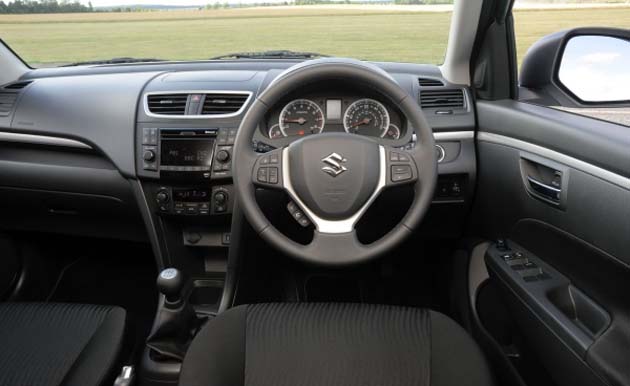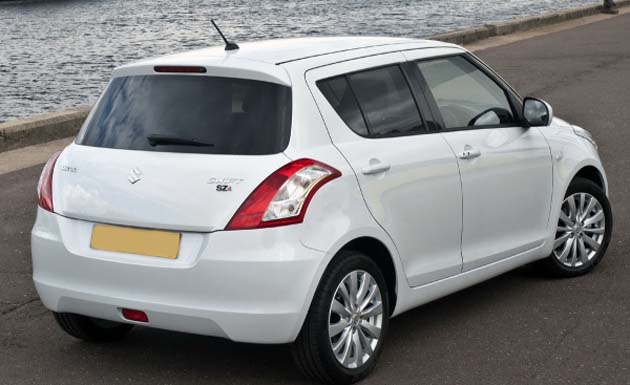Way back in 2005, I as a scrawny youngster, fresh out of college, joined Maruti Suzuki India Limited as their salesman. Back then all the cars were familiar to me as I had been seeing most of Maruti’s ageing lineup since the time I was born. But then the novelty of the thing hit me when I saw the Maruti Suzuki Swift in the very showroom where I was working. My first reaction was that it was a BMW Mini but then on second thoughts it struck me that it is only the design. The interiors also reeked of a freshness which was devoid even in the top of the line Baleno. But then, as luck would have it, I wasn’t assigned to the Swift team since there already was a waiting list for that vehicle and there was no need to push the sales for it. Cut to the present, I have the Maruti Suzuki Swift 2011 with me on a test drive almost 6 years after the original one was launched in India. We all knew that it was in the offing but then so long wasn’t predicted. Nevertheless, Maruti Suzuki India Limited have been kind enough to get us a sneak preview of the new Maruti Suzuki Swift 2011 model before its official launch in India.
Visually it isn’t much of a difference between the two but then headson, one can see the clear lens head lamps with their unique peeled back design. The snout of the car has grown a bit. By the way, Maruti or rather Suzuki have elongated the chassis to take care of the less interior space issue, but then more on it later. The grille as well as bumper ‘s however remain the same. It‘s good that Maruti have stuck to the adage “If it ain’t broken, then why fix it”. The appeal for the Swift was always its good looks and the Maruti Suzuki Swift 2011 model tries to stick to that formula with success.
The blackened A-pillar and the now more bulging wheel arches amplify the style statement. Though the car that I had with me for test came shod with 16 inch alloys, I am being told that this may change by May 2011 when the car would finally be launched. The most likely configuration would be 15 inch tyres as seen on the current top end version of the 2010 Maruti Suzuki Swift. I would have liked a Chevrolet Beat like hidden rear door handles on the new Swift but then that isn’t so. From the side profile, the new Swift somehow reminds me of the Hyundai i20 and the Nissan Micra. I think it is the boot shadow which makes me think of this. It is slightly bulging as opposed to the flat one on the 2010 Maruti Swift. The tail lamps are clear lens unit stretch along the length of the car. The major complaint amongst the Swift owners that it didn’t have a rear wiper has now been addressed to in the 2011 model.
The Maruti Suzuki Swift started the quality revolution in the Maruti stables. The Maruti Suzuki Swift 2011promises to take it to an all new level. Starting with the steering wheel, it is a slightly bigger unit than the old one and gets the much desired steering mounted controls as well as cruise control. I think I forgot to mention that it also has Bluetooth connectivity. The meter dials have been changed and the needles now exude the feel of the Honda City. Like the Polo, there is a new multi information display in the center flanked by two big circles which in turn are flanked by smaller ones at the extreme for displaying the fuel gauge and temperature parameters. The new Swift also gets a dead pedal. The ORVMs are now electrically adjustable. The one touch anti-pinch power windows are also a new addition. The dashboard as a whole has become more useful with its various cubby holes. Lots of Kizashi influence can be seen on this new car and it is a big thing considering that the Kizashi is available at approximately three times the cost of the Swift. The gear lever is something which has been carried forward from the old Swift. Build quality has improved to a certain extent but not much as I had expected. The Germans still make one of the best cabins around. Moreover, it is likely that Maruti would carry over the same black theme even for the new Swift. They had previously burnt their fingers with the Swift Glam edition which had an all beige interiors.
Front seats were excellent by any proportion for the older Swift but now they can accommodate even 6 foot plus individuals. I remember how I was ridiculed in Maruti 6 years back when I was trying to demonstrate to a customer about the internal boot release mechanism and had to clamber inside the car (without success). The back seats in the old Swift were the points of criticism for Maruti detractors. The wheelbase has been increased by 50mm and now the rear seat is a bit more bearable than the older one. Though my knees still banged against the front seats, they weren’t so forceful as to hurt the backsides of the front passenger. Maruti could do well to have some arrangement like scoops at the back of the front seats, like in the Alto K10, which would liberate more legroom. Head room was also just about sufficient and were it not for the hard gell that I had used for my hair that day, it would have been messed up. The rear bench now stands better inclined. It has got better underseat support and also the right foaming materials. Boot space issue hasn’t been addressed and if boot space is what stands as your priority, the go buy an Indica Vista or the Etios Liva. Boot space is just 204 liters.
Ohh, I forgot to tell you the novelty part of it. Maruti is mulling over to bring in keyless stop start atleast for the top variants. This is keeping in mind that the only other car in this segment which offers this is the Nissan Micra. The car I drove had this mechanism.
Handling was always the forte of the old Swift and the new one doesn’t disappoint either. The steering wheel now gets a new variable ratio as well as low play joints. It is direct like the older unit but a bit more taut now. But then once I turned in the steering, it felt dead for a moment and then regained its composure. Should be fine with the earlier Swift users but for new customers, it might take some time to get used to. The longer wheelbase doesn’t play around with the handling characteristics of the Maruti Suzuki Swift 2011 and this means that the car still handles like a dream. The 16 inch tyres that the test car had didn’t hamper its handling a bit. The chassis has been made more rigid now thanks to the use of high tensile steel in its construction. The suspension is still the old one and it means MacPherson struts in the front with torsion beam at the rear. The latter one is now lighter due to a better design and at the same time provides for a better roll stiffness.The torsion beam bushings also have 50% more lateral rigidity. I am not surr of the final tyre specifications of the Swift which would be launched in India but then 16 inchers are a visual treat as well as provide for better handling.
Ride quality which was somewhat compromised in the earlier versions has now been addressed. Infact, I can go as far as to say that it makes for a nice compromise between ride and handling. When you want good ride quality, it wouldn’t disappoint you and when you are in the mood to been a hooligan, it wouldn’t say no either. Though I couldn’t test it on the offbeat track, due to time limitations, its superlative ride quality to the earlier one left me impressed. NVH was something which is also down by a certain degree than the older car. This is because of the use of more sound deadening materials under the hood.
Engines would be carried over unchanged from the 2010 version. This means the choice of a 1.2 liter K series engine making 85 Bhp of power and peak torque of 113 Nm. The diesel engine would be the famed multijet from Fiat which is a 1.3 unit making 75 Bhp of peak power and 190 Nm of torque. Both the engines are mated to a 5 speed manual transmission which is one of the best units to be found in a small car. This time around, the car that I got was the diesel version unlike the 2010 Swift petrol that I had reviewed not long back. Needless to say, the car was sprightly to drive and with the free revving multijet diesel it was a hoot to drive around. Somehow the peak torque ratings would be altered for a bit more pizzazz before the car is launched. This is what a Maruti insider told me. Expect 1 or at the most 2 seconds to be shaved off the current timings of the old car. This in lieu of the weight chopping been done around. Fuel efficiency would also be stellar than the current one. Braking is the usual discs at front and drums at the rear with ABS and EBD thrown in. Unlike the earlier Swifts where the ABS was poorly calibrated, this one had good tinkering with ABS and this ensured safe braking distances. Safety is handled by the rigid chassis, 2 air bags, 3 point ELR seat belts with pretensioners and the side intrusion beams.
Another Swift gremlin namely the presence of squeaks and rattles has been eliminated to some extent. It didn’t seem like any plastic would fall off soon or over the years. Everything seems to be pretty well screwed up together. The earlier Swifts also had a problem of the boot rattling while going over bumps but not this one. I do hope that this sense of quality persists over the years. As of now, Maruti Suzuki India limited are tight lipped about the launch but then the insider pointed out that it would be near about May 2011, when the first car was launched 6 years ago. The Maruti Suzuki Swift 2011 price in India is expected to start from Rs 4.30 lakhs and would end at Rs 5.75 lakhs. All these are speculated price point considering Maruti’s earlier price offerings for a new car (forget the Kizashi and the Baleno).



Nice article. Could you give me suggestion on baleno vs swift?
ReplyDelete